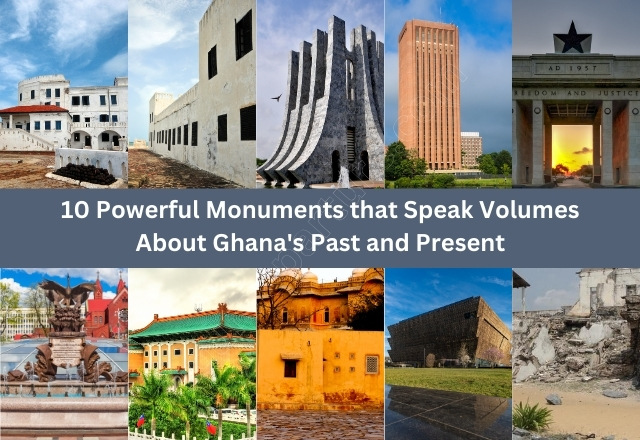Ghana was built with the fabric of resistance, the culture and the yearning for liberty. These threads are beautifully painted by the numerous monuments dotted across the country; all of which give out a different story about the past and the present. Here’s a curated list of 10 must-see monuments that will leave you enthralled
1. Cape Coast Castle: Cape Coast Castle is among the places in the world that has been listed as a UNESCO World Heritage site due to the sordid past it represents. This edifice was constructed in the 17th century by the Portuguese and it was a key point where slave trade was conducted. Today, there is a museum, and its corridors are filled with the history of suffering and courage. Visit the dungeons in which the prisoners were kept, walk through the ‘Gate of no return,’ and listen to the stories of the slave trade.
2. Elmina Castle: Built much earlier than Cape Coast Castle by about a century, Elmina Castle is the oldest remaining European building in the whole of sub-Saharan Africa. Another UNESCO World Heritage Site It was constructed for trading by the Portuguese but was later a hub for slaves. Trace its corridors and alleyways, try to enter the governor’s living quarters and ascend the battlements for a stunning view of the ocean. The construction of the Elmina Castle gives the heartsore account of the European colonization of Ghana.
- Kwame Nkrumah Mausoleum and Memorial Park: Moving from the dark history, the Kwame Nkrumah Mausoleum and Memorial Park are dedicated to the struggle and independence of Ghana and its leader. Kwame Nkrumah played an important role in the liberation and in 1957 Ghana became the first sub-Saharan country to gain independence. Visit his tomb and the nearby museum which tells the story of his life, his philosophy and the fight for independence.
4. W. E. B. Du Bois Memorial Centre for Pan-African Culture: Located on a hilltop looking out over the city of Accra, the W. E. B. Du Bois Memorial Centre for Pan-African Culture is dedicated to the man who fought for the rights of black people, W. E. B. Du Bois. Du Bois, who supported Pan-Africanism, died in Ghana. Visit his house now converted into a museum, peruse through his papers, and discuss his ideas that still fuel Pan-Africanism today.
5. National Museum of Ghana: Explore Ghana’s history in detail at the National Museum of Ghana. This vast museum contains an impressive collection of items that capture the culture and history of the nation from the pre-European contact period to the modern era. See the elegant gold weights, be fascinated by the ceremonial masks, and learn about Ghanaian customs and traditions.
6. Independence Square: Get a feel of the struggle for independence at Independence Square – a large square in which Ghanaians celebrated their freedom in 1957. Overemphasizing the architectural design of the square is the impressive Black Star Gate, which is a triumphal arch that represents the freedom of the nation of Ghana and its dreams for a better tomorrow. Visit the historic facility and watch the change of guard ceremony while being immersed in the patriotic spirit of the country.
7. Manhyia Palace Museum (Asantehene’s Palace): Visit one of the most important museums in Ghana – the Manhyia Palace Museum which is the official residence of the Asantehene, the king of the Ashanti people. This magnificent building is the epitome of Asante culture at its best. Be amazed at the beauty of the architectural designs of the courtyards, marvel at the carved wooden and gold trinkets hanging at the sides of the buildings and discover the cultural backgrounds of the Ashanti people.
- Kumasi Fort and Military Museum: Explore the military history of Ghana by visiting the Kumasi Fort which has been transformed into a museum of the nation’s defense. Visit the parapets, which were used as a military observation post and vantage point. The museum also hosts a display of arms, accouterments, and educative content on various wars that defined the history of Ghana.
9. Prempeh II Jubilee Museum: This museum is especially devoted to Asantehene Nana Prempeh II; it reveals more about the Ashanti Kingdom. Featuring items associated with his rule, the museum offers insight into how he helped maintain Asante traditions during British colonialism. See the beautiful golden king’s stool, the traditional Asante attire and other artifacts that depicted the life of the Asante kingdom during the reign of Prempeh II.
10. Fort Prinzenstein: This is a seventeenth-century, Portuguese fort situated in the picturesque town of Prinzenstein and thus offers a historical indulgence. Visitors can get onto the ramparts and have a view of the Atlantic Ocean. Visit the dungeons which are old structures and understand the function of the fort in the European commerce with the area.
Therefore, let this historical journey begin! The monuments of Ghana are sure to make for an interesting discovery about the tenacity of the country, its culture and its people.

